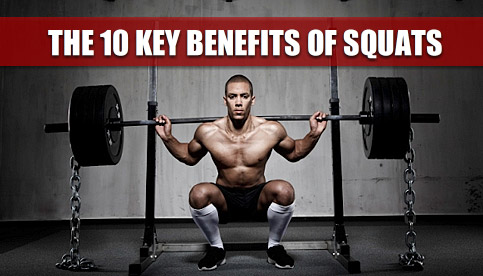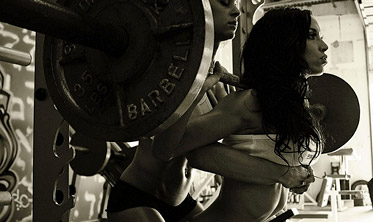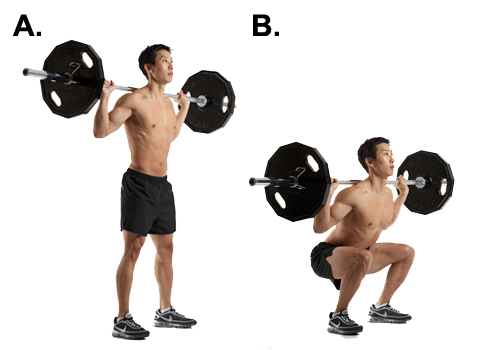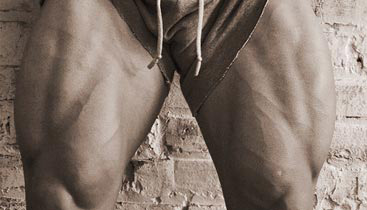THE 10 KEY BENEFITS OF SQUATS

No other lower body exercise in existence delivers more bang for the buck than a basic barbell squat.
It’s one of the most primitive movement patterns known to man and is without question the most productive leg exercise available for increasing overall muscle size, strength and performance.
While they certainly aren’t mandatory in order to build your lower body effectively, the benefits of squats extend to such a wide variety of different areas that I would definitely recommend including them in your plan as long as you’re physically able to.
Be prepared for a challenge though, as squats are one of the most physically and mentally demanding lifts out there. It’s no coincidence that the squat rack in most typical gyms remains empty gathering dust a good portion of the time.
The results you’ll achieve are well worth the effort though, and here are 10 reasons why…
10 Benefits Of Squats You Should Know About

#1 – Powerful muscle size and strength builder.
This is the most obvious one on the list of squat benefits, but it certainly has to be mentioned.
Squats allow you to handle a large amount of weight and are an incredibly effective means of stimulating size and strength gains throughout your entire lower body. In fact, performing this one lift alone would allow you to develop a very impressive lower body even if you never included any other exercises at all.
Research has shown that strength is gained the fastest on the movement that is positioned first in the workout, and I’d suggest placing a basic barbell squat into this slot in order to get the very most out of the exercise.
#2 – Highly efficient.
While the quadriceps are the primary targeted muscle here, squats hammer a wide variety of major muscle groups all at the same time.
What do squats work? Along with building size and strength in your quads, you’ll also be significantly activating your glutes, hamstrings, spinal erectors, abdominals, obliques and even your calves to a degree.
There’s simply no other exercise out there that allows you to train your lower body as efficiently as a basic squat will.
Because of the many muscles that are involved, squats allow you to achieve progressive overload at a relatively fast pace in comparison to other lifts, which is the most important factor of all when it comes to adding muscle size.
This is especially true if you’re a beginner, in which case you should be able to add more weight to your squats pretty much every single week for a fairly lengthy period of time before reaching any sort of strength plateau.
#3 – Functional exercise.
The squat is a basic, primal movement pattern that humans and our ancestors have been performing for millions of years through activities such as hunting, gathering, harvesting, cooking and eating.
While any weight training exercise that you perform is technically “functional” to a certain degree, squats have a much higher carry-over to regular day to day activities in comparison to most other common muscle building exercises that are performed in the gym.
Training to look good is perfectly fine, but having a body that performs well is just as important.
#4 – Reduces injury risk.
Long gone are the days of avoiding squats because they’re “bad” for your knees and lower back. In fact, as long as you execute your squats using proper form and technique, the literal opposite is true. This is one of the many important benefits of squats that is often over-looked.
The majority of athletic injuries occur as a result of weak connective tissues, ligaments and stabilizing muscles, and squats help to strengthen all of these smaller structures to give you a strong and sturdy foundation that is less susceptible to injuries.
Any serious lifter should focus on strengthening both the muscles and the supporting structures as a long term strategy for consistent, injury free progress.
#5 – Improves core strength.
Throughout an entire squat, the muscles of your core are forced to work extra hard to keep your body upright and to support your lower back.
This improves your overall core strength, which:
– Carries over to improved strength and performance on other compound exercises.
– Protects your lower back from injury.
– Stimulates muscle growth in your abdominals and obliques.
#6 – Boosts vertical jump.
Squats build significant hip extension strength, which allows you to explode off of the ground more powerfully and improve your vertical leap.
Not only do squats improve your ability to produce power, but they also improve your ability to absorb it. This means that you’ll be able to jump higher and you’ll decrease your chances of injury on the way down as well.
If you’re involved in any sport where vertical jumping is of particular importance, such as track and field, basketball, volleyball or even football, or if you just like the idea of having a bigger vertical jump, then increasing your squatting strength should be given central focus in the gym.
#7 – Enhances sprinting speed.
Not only does this improvement in leg drive allow you to jump higher, but you’ll also be able to run faster as well.
Many studies exist showing a direct correlation between maximal squat strength and sprinting performance, and a quick look at the quad, hamstring and glute development of most world-class sprinters should make it obvious as to just how large a role these muscles play.
Increased sprinting speed benefits athletes of virtually any sport to a certain extent, and consistent squatting is one of the best ways to help you achieve this.
#8 – Increases mobility and flexibility.
Full range of motion squats not only add muscle onto your entire lower body, but they also improve overall flexibility and mobility as an added bonus by increasing the range of motion of your ankles, knees, hips and lower back.
This improvement in flexibility and mobility will carry over to many other exercises and regular day to day activities, which further reduces your chances injury and improves overall performance.
#9 – Builds mental toughness.
Squats are arguably the single most demanding exercise out there, and if you’ve ever performed a heavy set of squats at maximum intensity then you know exactly what I’m talking about.
Unlike a deadlift that allows for brief rest periods when the weights touch the ground, squats force you to remain fully active throughout the entire exercise as you fight to not only grind out each rep, but to balance the bar on your back the entire time as well.
Combine that with the large number of muscle groups involved and the heavy weights that can be handled and this is one exercise where you’ll really need to buckle down and focus.
Master the squat and everything else you do in the gym will seem like a walk in the park in comparison.
#10 – Simple and highly versatile.
You don’t need any fancy tools or gym equipment to perform squats, and all it takes is a basic barbell and squat rack to get the job done. Any standard commercial gym will have this equipment available, and even if you train from home you should be able to get your own setup going fairly easily.
Even if you don’t have access to a squat rack though, there are still a ton of different squat variations available that you can use in place of the traditional barbell squat, such as dumbbell squats, split squats, goblet squats, Zercher squats, single-leg body weight squats or barbell hack squats just to name a few.
How To Do Squats Properly
As you can see, squats are a highly effective, multi-purpose lift that will deliver quite a few individual benefits to your strength training program.
However, proper form is of paramount importance here, as most squat exercises do allow you to handle a lot of weight and are a more complicated movement from a technical standpoint than most other lifts.
Use improper technique or go too heavy (or even worse, a combination of both), and you could very easily run into problems.
If you’re just starting out with this exercise then make sure to keep the weights light and gradually increase over time rather than making any big sudden jumps.
Here’s the basic form you’ll want to follow…
(You can also view a video tutorial here if you’re prefer)

Proper Squat Form
1) Step into the squat rack and adjust the pins so that you can un-rack the bar comfortably. You should also make sure that the safety catches are in place in case you reach failure and can’t lift the weight out of the bottom position.
2) Space your feet just outside of shoulder-width apart with your toes pointing slightly outward and rest the bar on your rear shoulders.
3) Grip the bar with your hands spaced evenly apart, clear the bar off of the pins and step back.
4) Look straight ahead with your chin pointed slightly up, keeping your chest up and shoulder blades slightly pinched together.
5) Start the movement by bending at the knees and hips and squatting down toward the floor. Make sure to maintain a neutral spine, tight core and slight arch in your lower back, pushing your knees outward throughout the movement.
6) Continue to descend until your thighs are parallel to the floor. Once you reach the bottom, drive the weight back up through your heels until you are in a standing position. Repeat for desired number of reps.
Benefits Of Squats: Wrapping It Up

So, unless there is a specific reason why you cannot perform them (such as an injury), squats should definitely be included as part of your weekly training schedule.
They’ll pack significant size and strength onto your entire lower body (particularly the quads, glutes and hamstrings), improve your functional strength, increase athletic performance, reduce the chances of injury, improve flexibility and enhance core strength just to name a few benefits.
If that isn’t a great list of reasons to get into the squat rack then I don’t know what is.
My recommendation is to perform your squats 1-2 times per week for 3-4 sets of 5 to 12 reps. I generally prefer staying on the lower end however, as higher rep squats bring the cardiovascular system heavily into play which can reduce overall muscular performance.
Squats are incredibly intense and demanding, but for serious lifters the resulting benefits of squats are well worth it. If squats isn’t your type of exercise, you could always try sports like soccer, golf or Tennis Lessons Los Angeles to help you get fit.
If you found this article helpful, make sure to sign up for your FREE custom fitness plan below...




